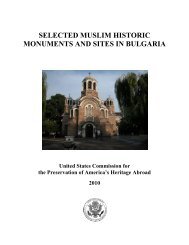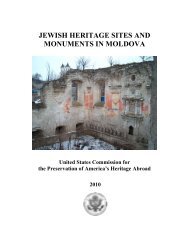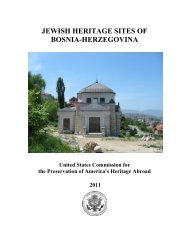jewish cemeteries, synagogues, and mass grave sites in ukraine
jewish cemeteries, synagogues, and mass grave sites in ukraine
jewish cemeteries, synagogues, and mass grave sites in ukraine
You also want an ePaper? Increase the reach of your titles
YUMPU automatically turns print PDFs into web optimized ePapers that Google loves.
(Lviv square). Unfortunately, there is no <strong>in</strong>formation about Jewish <strong>cemeteries</strong> from that time,<br />
but at least one Jewish cemetery must have existed <strong>in</strong> Kyiv. Then, beg<strong>in</strong>n<strong>in</strong>g <strong>in</strong> the 12 th century,<br />
Jews entered the territory of Ukra<strong>in</strong>e from Western Europe <strong>in</strong> the wake of the expansion of the<br />
Teutonic Knights <strong>and</strong> other Christian forces. Jews also migrated to Ukra<strong>in</strong>e from the east due to<br />
the persecution aga<strong>in</strong>st Judaism from Russian <strong>and</strong> Byzantium Orthodox clergy.<br />
The most active period of migration to western Ukra<strong>in</strong>e was <strong>in</strong> the 16 th <strong>and</strong> 17 th centuries when<br />
the region was under Polish rule. The Polish nobility <strong>in</strong>vited Jews to help manage their estates<br />
<strong>and</strong> develop economic activity <strong>in</strong> the newly founded private towns. Predom<strong>in</strong>antly Jewish<br />
towns (shtetls) began to appear on Ukra<strong>in</strong>ian territory as early as the 15 th century when the<br />
Polish aristocracy <strong>in</strong>vited Jews to settle. By the 17 th century, Jews began also to settle <strong>in</strong> eastern<br />
Ukra<strong>in</strong>e. Jewish communities appeared <strong>in</strong> Podillia, <strong>and</strong> farther to the east <strong>in</strong> the towns of Rivne,<br />
Chernihiv, Bila Tserkva, Bohuslav, Perejaslav, Pyriatyn, Lokhvytsia, Dubno, etc. Architectural<br />
rema<strong>in</strong>s <strong>and</strong> <strong>cemeteries</strong> <strong>in</strong> these areas date from this period.<br />
Thus, from the 16 th century until 1939, the largest <strong>and</strong> most important Jewish community <strong>in</strong> the<br />
world was located <strong>in</strong> Eastern Europe <strong>in</strong> the region that was first under the control of the Polish-<br />
Lithuanian K<strong>in</strong>gdom, much of which later became part of the Russian Empire. Approximately<br />
half of this historic region is now part of the new modern nation of Ukra<strong>in</strong>e, which ga<strong>in</strong>ed<br />
<strong>in</strong>dependence <strong>in</strong> 1991.<br />
Western Ukra<strong>in</strong>e was the site of some of the earliest Jewish settlements. By 1447, a Jewish<br />
community was established <strong>in</strong> Sambir, <strong>and</strong> soon afterward Jews settled <strong>in</strong> Uzhhorod, which<br />
became a Jewish religious center (this area was part of Czekhoslovakia between the World<br />
Wars). At Berehovo, then part of Hungary, Polish Jews were encouraged to settle on the estates<br />
of the Schoenborn counts. Mukachevo was once home to thirty <strong>synagogues</strong> <strong>and</strong> had a Hebrew<br />
press established <strong>in</strong> 1871.<br />
Beg<strong>in</strong>n<strong>in</strong>g <strong>in</strong> the 16 th century, Ukra<strong>in</strong>e was the site for nearly every major religious, social, <strong>and</strong><br />
political movement <strong>in</strong> the Jewish world. Despite the devastation of the Chmelnytskyj <strong>mass</strong>acres<br />
<strong>in</strong> 1648 (<strong>in</strong> which 100,000 Jews died), the Jewish community cont<strong>in</strong>ued to grow <strong>and</strong> develop.<br />
Israel B. Eliezer, known as the Ba’al Shem Tov (c. 1698 – 1760) founded Hasidism, the popular<br />
religious movement, <strong>in</strong> the western Ukra<strong>in</strong>ian regions of Podillia <strong>and</strong> Volyn dur<strong>in</strong>g the first half<br />
of the 18 th century.<br />
The teach<strong>in</strong>g <strong>and</strong> practice of Hasidism offered hope <strong>and</strong> dignity to a large portion of the Jewish<br />
population of Eastern Europe, particularly those who were looked down upon by the Jewish<br />
establishment of community leaders <strong>and</strong> scholarly rabbis because of their semi-literacy,<br />
ignorance of Jewish law, <strong>and</strong> poverty.<br />
The Ba’al Shem Tov <strong>and</strong> his followers placed prayer <strong>and</strong> faith on an equal foot<strong>in</strong>g with<br />
scholarship <strong>and</strong> knowledge of the law. Thus, through a religious movement, a large Jewish<br />
underclass was recognized as a powerful <strong>and</strong> legitimate religious <strong>and</strong> social force. With<br />
Hasidism, even the ignorant could f<strong>in</strong>d div<strong>in</strong>e grace <strong>in</strong> prayer with purity of heart, devotion, <strong>and</strong><br />
enthusiasm.<br />
14









